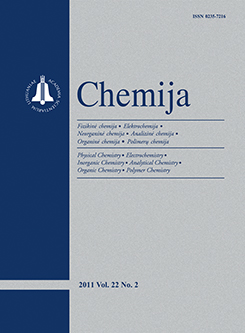Chemija / Chemistry
 ISSN 0235-7216 ISSN 2424-4538 (online) |
2016 m. Nr. 2 Kinetic properties of flavocytochrome b2 from Hansenula polymorpha
Flavocytochrome b2 (fcb2) (EC 1.1.2.3) is a 4 × 58 kD homotetrameric FMN and heme containing enzyme localized in the intermembrane space of yeast mitochondria. During the catalysis, FMN oxidizes L-lactate to pyruvate. Subsequently, the reduced FMN transfers electrons to the heme cofactor, which subsequently reduces cytochrome c. The kinetic properties and thermostability of the enzyme depend on its source, and these factors may be important in the construction of biosensors for L-lactate based on fcb2. In this work, we have investigated the kinetic properties of fcb2 from the thermotolerant methanotrophic strain Hansenula polymorpha. Like in our previous studies of Saccharomyces cerevisiae fcb2 [1], H. polymorpha fcb2 exhibited biphasic Lineweaver–Burk plots at fixed L-lactate concentrations using varied ferricyanide concentrations. It reflects the acceptance of electrons from both the reduced FMN and heme after the slower intramolecular FMN-to-heme electron transfer. At the infinite L-lactate concentration, the maximal rate of ferricyanide reduction is close to 120 s–1. The maximal rate of cytochrome c reduction is close to the second (slower) phase of ferricyanide reduction, because cytochrome c accepts electrons only from heme. The reaction product pyruvate inhibits H. polymorpha fcb2 in a mixed way at the millimolar concentration, and decreases the maximal rates of both fast and slow phases of ferricyanide reduction. : Keywords: flavocytochrome b2, steady-state kinetics, cytochrome c, redox reactions |
Issues:
2017 - Vol.28 No. 1, No. 2, No. 3, No. 4 2016 - Vol.27 No. 1, No. 2, No. 3, No. 4 2015 - Vol.26 No. 1, No. 2, No. 3, No. 4 2014 - Vol.25 No. 1, No. 2, No. 3, No. 4 2013 - Vol.24 No. 1, No. 2, No. 3, No. 4 2012 - Vol.23 No. 1, No. 2, No. 3, No. 4 2011 - Vol.22 No. 1, No. 2, No. 3, No. 4 2010 - Vol.21 No. 1, No. 2-4 2009 - Vol.20 No. 1, No. 2, No. 3, No. 4 2008 - Vol.19 No. 1, No. 2, No. 3-4 2007 - Vol.18 No. 1, No. 2, No. 3, No. 4 2006 - Vol.17 No. 1, No. 2-3, No. 4 2005 - Vol.16 No. 1, No. 2, No. 3-4 2004 - Vol.15 No. 1, No. 2, No. 3, No. 4 2003 - Vol.14 No. 1, No. 2, No. 3, No. 4 2002 - Vol.13 No. 1, No. 2, No. 3, No. 4 2001 - Vol.12 No. 1, No. 2, No. 3, No. 4 |